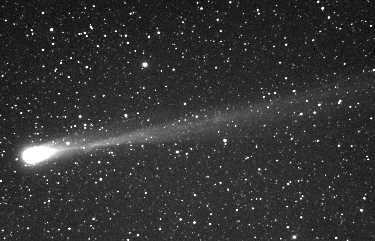In this month: March
10th March 1977
While observing the planet Uranus passing in front of a distant star (SAO 158687), scientists at the Kuiper Airborne

Observatory make a major discovery: Uranus, like Saturn, has rings. The rings were the first to be found around a planet other than Saturn. Most of Uranus's rings are opaque and only a few kilometres wide, and thought to be relatively young, not more than 600 million years old.
Further rings were discovered in 1986 from the Voyager 2 spacecraft, and in 2003-2005 with the Hubble Space Telescope, bringing the total number known to 13. Image left NASA/Erich Karkoschka (Univ. Arizona).
The origin and history of the rings are unknown. One possible theory is they originated from a collision of several moons that once orbited Uranus.
25th March 1996
Comet Hyakutake makes its closest approach to Earth at a distance of 15 million kilometres, or 0.1 AU. Hyakutake was moving so rapidly across the night sky its movement could be detected against the stars in just a few minutes.

It covered half a degree, or the diameter of a full Moon, every 30 minutes.
Dubbed the Great Comet of 1996, its passage near Earth was one of the closest cometary approaches of the previous 200 years. Before its most recent journey through the Solar System, its orbital period was about 17,000 years, but the gravitational influence of the giant planets has increased this to 70,000 years.
7th March 2009
The Kepler Space Telescope is launched. The image below is courtesy of NASA Credits: NASA/Wendy Stenzel .

The telescope was designed to discover Earth-size exoplanets orbiting other stars. During its nine and a half years of service it observed 530,506 stars and detected 2,662 planets. The mission revealed that in our galaxy there are more planets than stars, and small planets are common with an abundance of terrestrial-size worlds.
Named after the astronomer, Johannes Kepler, the telescope was shut down on the 30th October 2018, the 388th anniversary of Kepler’s death in 1630.
BORN
6th March 1787
Joseph von Fraunhofer. Bavarian physicist and optical lens manufacturer. He made optical glass and achromatic telescope lenses, invented the spectroscope, and developed diffraction grating, a device that disperses light more effectively than a prism. In 1814, he discovered and studied the dark absorption lines in the spectrum of the sun now known as Fraunhofer lines. The image below is a photogravure from a painting by Richard Wimmer. of Fraunhofer demonstrating his spectroscope.

Counted as one of the founders of modern optics, he succeeded in manufacturing telescopes in a quality that had never been seen before. He died in 1826 at the age of 39. Like many glassmakers of his era, he was poisoned by heavy metal vapours, resulting in his premature death.
21st March 1866
Antonia Maury. American astronomer.

The first to detect and calculate the orbit of a spectroscopic binary. Maury published an early catalogue of stellar spectra using her own system of stellar classification, which was later adopted by the International Astronomical Union. She was part of the Harvard Computers, a group of female astronomers at Harvard College Observatory.
Maury was a member of the American Astronomical Society and the Royal Astronomical Society. In 1943, she was awarded the Annie Jump Cannon Award in Astronomy by the American Astronomical Society. Image left courtesy Harvard College Observatory.
The lunar crater Maury is named in her honour.
28th March 1941
David Malin AM. British-Australian astronomer and photographer.
Known for his spectacular colour images of astronomical objects. In 1975 he moved to Australia to take up a job with the Anglo-Australian Observatory (AAO), now the Australian Astronomical Observatory.
Image Right by Bob Bee of David Malin on the roof of Paris Observatory.

In 1986 he discovered a giant spiral galaxy, Malin 1, which is named after him, located 1.19 billion light-years away in the constellation Coma Berenices. It is the largest spiral galaxy so far discovered.
In 2019 he was made a Member of the Order of Australia (AM).
The minor planet 4766 Malin is named after him.

